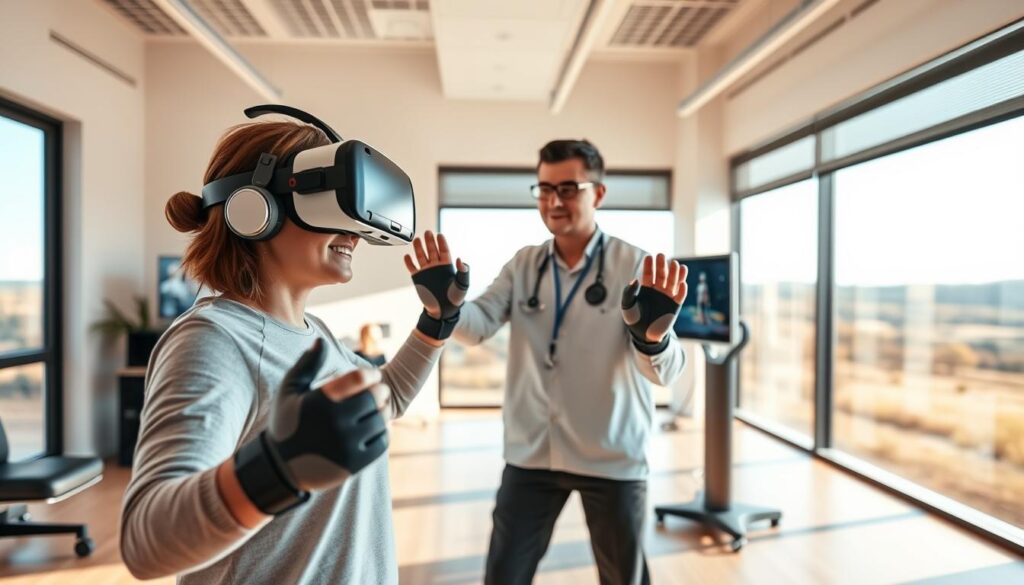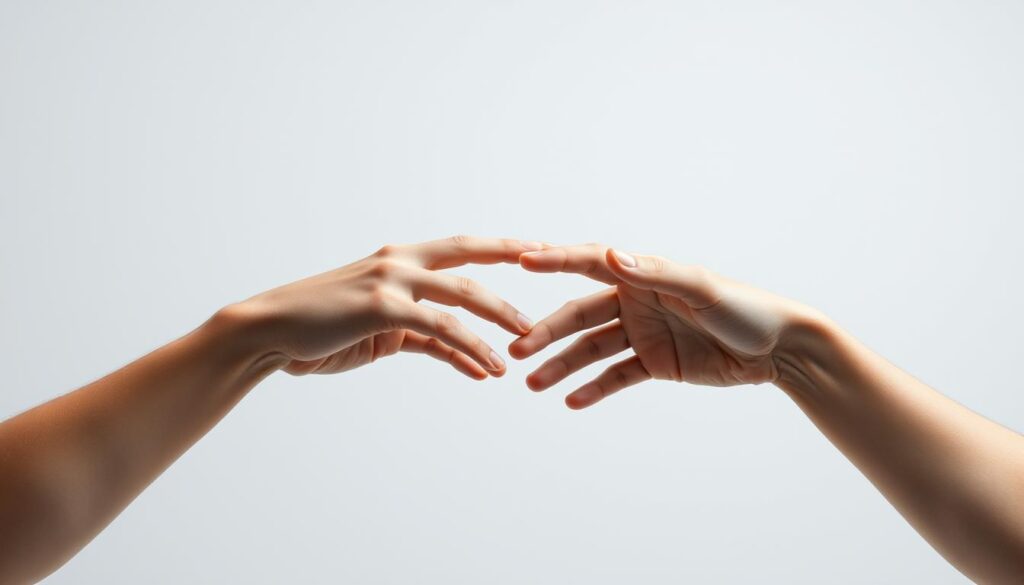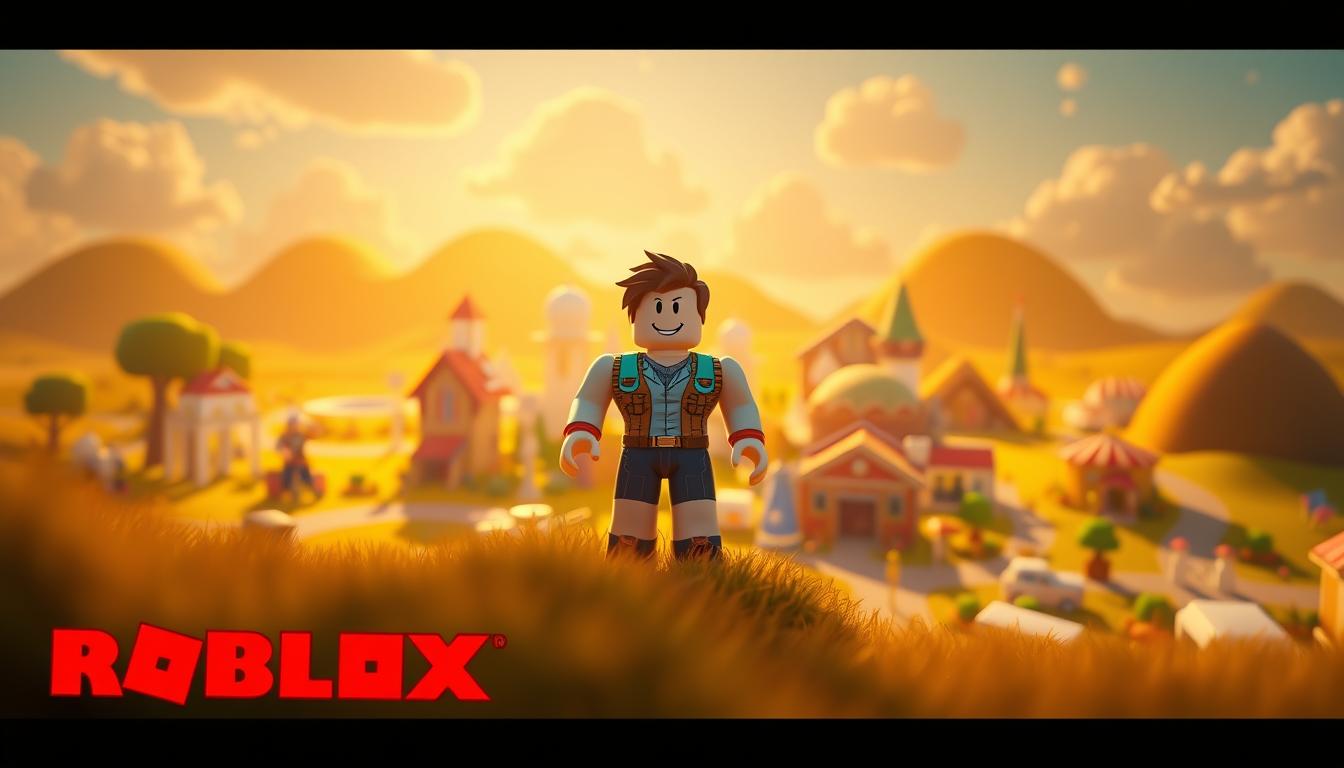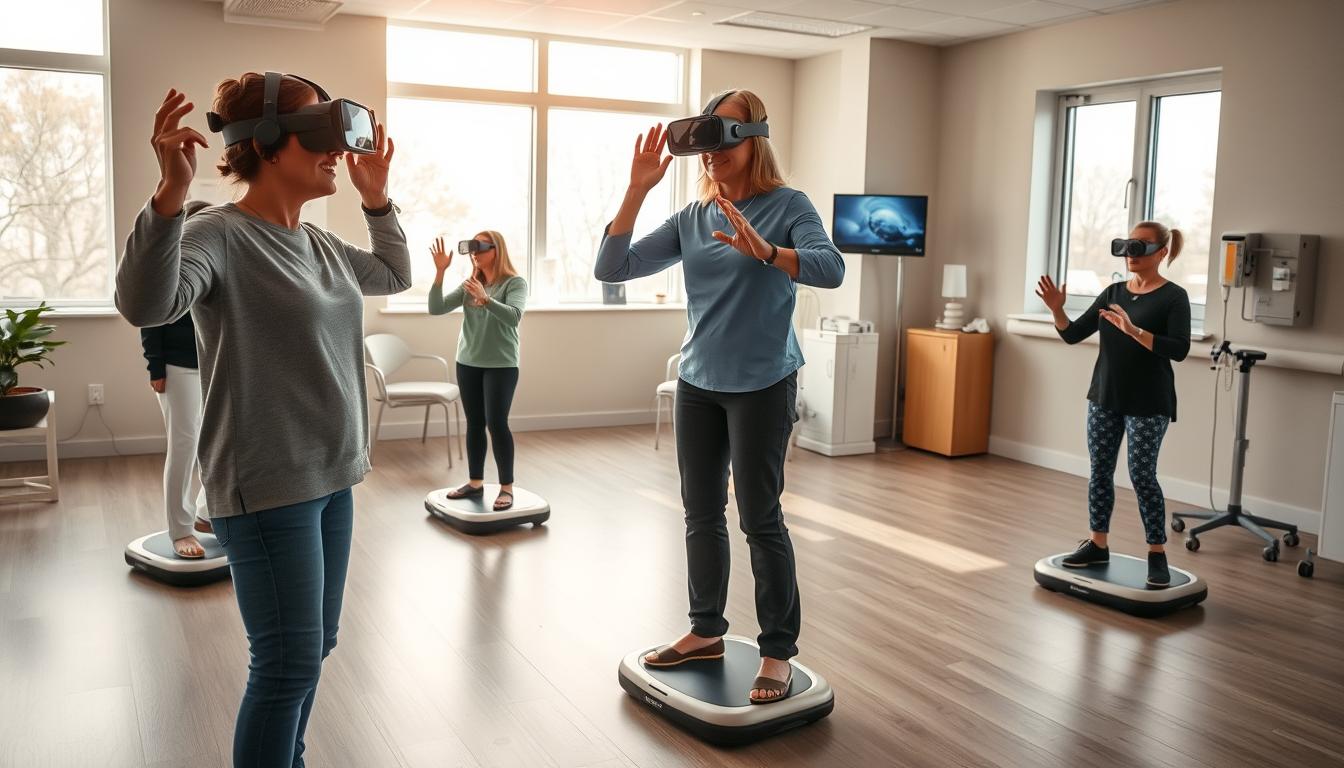Anúncios
What if the key to enhancing recovery after a stroke or neurological condition lies not in traditional therapy, but in engaging and immersive virtual reality games?
Healthcare professionals are now using VR rehabilitation to improve arm coordination and dexterity. Patients can play tailored virtual reality games during therapy. This makes therapy sessions more fun and interactive.
Anúncios
This new approach not only changes how we treat stroke patients but also makes therapy more effective. It uses adaptive and engaging platforms. Discover how VR games are opening new doors for recovery and setting a new standard in patient care.
Introduction to Virtual Reality in Rehabilitation
Virtual reality rehabilitation is changing the way we help people recover from strokes and other neurological issues. It creates a world where patients can practice real-life tasks in a safe space. This makes therapy more fun and helps patients stay motivated.
Therapists can now make therapy plans that fit each patient’s needs. This makes therapy more effective. Research shows that virtual reality helps patients stick to their treatment plans and recover better.
Anúncios

Understanding Bilateral Arm Coordination
Bilateral arm coordination is key in rehab, especially for stroke survivors. It means using both arms together for tasks. This skill is vital for getting back to daily life.
Therapists focus on activities that boost this coordination. Studies show it helps in recovery.
The Importance of Coordination in Rehabilitation
Good bilateral coordination helps stroke patients move and do daily tasks again. Through rehab, they learn the motor skills needed. Exercises that improve coordination are part of successful treatment plans.
Functional Neuroplasticity and Learning New Motor Skills
The brain’s ability to change and adapt is called neuroplasticity. It’s crucial in stroke recovery. Motor skill learning uses this ability.
Research shows that doing the same tasks over and over changes the brain. This leads to better recovery. Exercises that improve bilateral coordination help the brain adapt, leading to better results in rehab.

How VR Supports Motor Skill Development
Virtual reality is changing the game in rehabilitation, especially for improving VR motor skills. It creates immersive therapy environments where patients can safely practice their motor skills. These environments work on both sight and touch, making therapy more effective and engaging.
Engaging Virtual Environments for Therapy
Virtual settings are perfect for therapy because they grab patients’ attention and keep them involved. Simulations can be made to look like real life, asking patients to use different muscles together. This not only helps with physical rehab but also keeps the mind active as patients tackle challenges.
Enhancing User Motivation Through Interaction
VR’s impact on motivation is huge. Patients are more motivated in dynamic and rewarding spaces. Features like instant feedback and games make users want to do better. This positive approach helps patients stick with their rehab, leading to better results.
Features of VR Rehabilitation Platforms for Bilateral Upper Limb Coordination
VR rehabilitation platforms have advanced features to help with upper limb coordination. They use the latest tech for a personalized and immersive experience. This leads to better therapy results. Key features include adaptive training and haptic feedback.
Adaptive Training Algorithms
Adaptive training is key in VR therapy. These algorithms adjust tasks based on how well you do them. This keeps you challenged but not overwhelmed, helping you improve steadily.
It makes therapy feel more like a personal achievement. This keeps you motivated to keep going with your therapy.
Integration with Haptic Feedback Technologies
Haptic feedback makes virtual tasks feel real. It gives you physical sensations that feel like real-world actions. This makes your therapy more effective.
It helps improve your fine motor skills. You also get a better sense of how your actions affect the virtual world. This focus helps you improve faster.
Adaptive training and haptic feedback make therapy better. They help improve upper limb coordination. This makes therapy more effective for those recovering from neurological issues.
Top VR Games for Stroke Rehabilitation
Virtual reality is changing stroke rehab, offering fun ways to improve hand skills. The best VR games help patients work on key recovery skills. Each game targets different motor skills, making them great for stroke recovery.
Piano Trainer: Fractionation and Coordination
Piano Trainer uses music to boost fine motor skills and finger coordination. Players tap virtual keys to music, making it fun to practice dexterity. It’s a top pick for improving hand skills in VR.
Hummingbird Hunt: Dynamic Grasp and Release
Hummingbird Hunt lets players grasp and release virtual objects. It’s like real-world movement, improving hand-eye coordination and smooth movements. It’s a great tool for stroke recovery.
Placing Cups: Functional Reaching Tasks
Placing Cups focuses on daily tasks like reaching for cups. Players put virtual cups in spots, building strength and control. It’s key for real-life tasks and successful rehab.
Reach/Touch: Enhancing Shoulder and Elbow Movement
Reach/Touch boosts shoulder and elbow mobility with fun challenges. It’s vital for upper limb flexibility and movement agility. Players get a structured space for consistent practice.
Benefits of Using VR Games in Rehabilitation
VR games in rehab offer many benefits, especially for upper body recovery. They create a special space for people to dive into their therapy. This makes the process more engaging and meaningful.
Improvement in Upper Extremity Function
VR helps improve upper body function, studies show. Patients do exercises in virtual worlds that feel like real tasks. This boosts their motor skills and hand-eye coordination safely.
Increased Engagement and Enjoyment for Patients
Getting patients to stick with therapy is key. VR games make therapy fun and exciting. This leads to more active and productive sessions, helping patients recover better.
Real-Time Feedback and Monitoring
VR gives patients instant feedback during therapy. They see how they’re doing right away. This helps them adjust and stay on track to reach their goals.
Evidence Supporting VR Rehabilitation
Virtual reality (VR) is becoming more common in rehabilitation. Many VR effectiveness studies show its benefits. These studies suggest VR can help patients recover faster, especially those with neurological issues.
VR seems to improve on traditional methods. It offers better results for patients.
Research Studies on VR Effectiveness
Studies have looked into VR’s role in rehab. They found VR boosts upper limb function and motivates patients. Patients using VR show better motor skills than those without it.
Comparative Analysis with Traditional Rehabilitation Methods
VR and traditional rehab differ in how they engage patients. Here’s a table comparing them:
| Factor | Traditional Rehabilitation | VR Rehabilitation |
|---|---|---|
| Patient Engagement | Moderate | High |
| Motivation Levels | Varies | Consistently High |
| Recovery Speed | Slower | Faster |
| Feedback and Adaptation | Limited | Real-Time |
This comparison shows VR’s potential in rehab. It could be a key part of future treatments. As more rehabilitation evidence comes in, VR is seen as a valuable tool.
Patient-Centric Approach in VR Rehabilitation
Using a patient-centric approach in VR rehabilitation is key to better treatment. It means making therapy fit each patient’s needs for a more effective journey. This way, therapy is not just about the treatment but also about the patient’s preferences and abilities.
Customizing VR Experiences for Individual Needs
Customizing therapy in VR makes it more personal. Therapists can match treatment to each patient’s goals. This makes therapy more interesting and motivating for patients.
When therapy matches their lives, patients are more likely to be involved. This can lead to better results because they are more invested in their treatment.
Role of Occupational and Physical Therapists
Occupational and physical therapists are crucial in patient-centric rehabilitation. They use their knowledge to make VR therapy fit each patient’s needs. They pick the right VR experiences to help patients reach their goals.
Considerations When Implementing VR Rehabilitation
Using VR in therapy comes with many things to think about. Healthcare providers need to know the possible problems. Issues like VR side effects can make patients uncomfortable.
Figuring out how to deal with these issues is key. It helps make VR therapy work better for everyone.
Potential Side Effects and Limitations
VR is a new way to help people get better, but it can cause problems. Some people might feel sick or uncomfortable while using it. This can make it hard for them to stay involved.
Getting patients used to VR slowly can help. Also, knowing what VR can and can’t do is important. This helps plan treatments better.
Cost and Accessibility of VR Platforms
How much VR costs is a big deal. It can be expensive, which might stop some places from using it. Knowing about different VR options can help therapists choose wisely.
Not everyone can use VR, which is another problem. Making VR more available could help more people get help. This could be through community programs or working with tech companies.
Future of VR in Neurological Rehabilitation
The world of neurological rehabilitation is on the verge of a big change thanks to VR. Researchers and developers are working hard to bring new technologies to therapy. They aim to make treatments more personal and effective for each patient.
Emerging Trends and Technologies
Rehabilitation is changing fast, thanks to VR. Therapy is now more fun and interactive. Tools like wearables and data analytics help therapists see how patients are doing.
VR games and stories make therapy more exciting. This helps patients stay motivated and involved in their treatment.
Long-Term Implications for Patient Care
VR in rehabilitation is set to make a big difference in patient care. It promises better results by keeping patients engaged. Patients might live better lives as they learn new skills.
These technologies could become a key part of treating neurological conditions. They could change how we approach rehabilitation for the better.
Getting Started with VR Rehabilitation
Starting VR rehabilitation is both exciting and challenging. It brings new ways to help patients recover. Choosing the right VR system is key to success. It makes sure virtual reality helps in therapy.
Choosing the Right VR System for Your Needs
When starting VR rehabilitation, picking the right system is crucial. Consider these factors:
- Therapeutic Goals: Know what you want to achieve to pick the right system.
- User-Friendliness: Pick systems that are easy for everyone to use.
- Compatibility: Make sure it works with your current therapy tools.
- Cost-Effectiveness: Think about the cost and value over time.
Integrating VR into Your Rehabilitation Plan
Integrating VR into therapy plans needs careful planning. Here’s how to do it right:
- Assessment: Start by assessing each patient’s needs for a personalized VR experience.
- Training: Train both therapists and patients to get the most out of VR.
- Monitoring Progress: Keep track of how patients are doing and adjust therapy as needed.
- Feedback Loop: Use feedback from patients and therapists to make the experience better.
Conclusion
VR rehabilitation is a big step forward in treating stroke and neurological conditions. It makes therapy more fun and helps patients get better faster. VR uses special algorithms and feedback to tailor training to each person’s needs.
VR games do more than just help with coordination. They also boost upper limb skills and keep patients interested. The research shows VR can really change how we help people recover.
Using VR in therapy helps patients in many ways. It’s a key part of making care better. VR is leading the way in making rehabilitation more effective and engaging.
FAQ
What is virtual reality (VR) rehabilitation?
Virtual reality (VR) rehabilitation uses immersive tech to help patients with strokes and brain injuries. It creates interactive, changing environments that boost patient interest and help them recover better.
How does VR help with bilateral arm coordination?
VR makes patients do exercises to better arm coordination by mimicking real tasks. This practice helps the brain make new connections, improving motor skills and recovery.
What are the benefits of using VR games in rehabilitation?
VR games have many benefits. They improve arm function, make therapy more fun, and give feedback right away. This helps patients recover faster.
Are there any side effects associated with VR rehabilitation?
Yes, VR can cause motion sickness or discomfort. It’s key to watch patients closely and adjust sessions to lessen these issues.
What specific VR games are effective for stroke rehabilitation?
Good VR games for stroke rehab include Piano Trainer for finger work, Hummingbird Hunt for hand movement, Placing Cups for reaching, and Reach/Touch for shoulder and elbow practice.
How do therapists integrate VR into treatment plans?
Therapists tailor VR experiences to meet each patient’s goals and abilities. They mix VR with traditional therapy for a full care plan.
What future trends can we expect in VR rehabilitation?
VR rehab will see more advanced sensors and AI for better engagement and feedback. These updates aim to boost therapy results and improve patients’ lives.
How can patients get started with VR rehabilitation?
Patients should talk to their doctors to see if VR rehab is right for them. They’ll set goals and pick the right VR system for their therapy plan.




